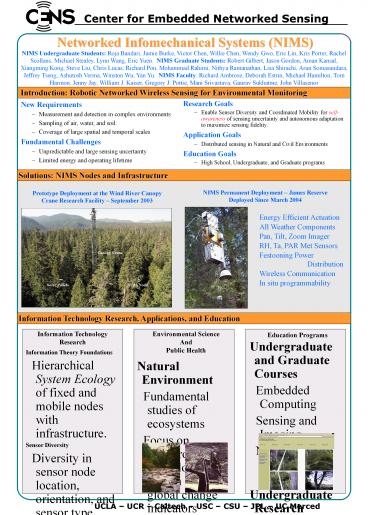Networked Infomechanical Systems (NIMS) PowerPoint PPT Presentation
1 / 1
Title: Networked Infomechanical Systems (NIMS)
1
Networked Infomechanical Systems (NIMS)
Center for Embedded Networked Sensing
NIMS Undergraduate Students Roja Bandari, Jamie
Burke, Victor Chen, Willie Chen, Wendy Gwo, Eric
Lin, Kris Porter, Rachel Scollans, Michael
Stealey, Lynn Wang, Eric Yuen. NIMS Graduate
Students Robert Gilbert, Jason Gordon, Aman
Kansal, Xiangming Kong, Steve Liu, Chris Lucas,
Richard Pon, Mohammad Rahimi, Nithya Ramanathan,
Lisa Shirachi, Arun Somasundara, Jeffrey Tseng,
Ashutosh Verma, Winston Wu, Yan Yu. NIMS
Faculty Richard Ambrose, Deborah Estrin, Michael
Hamilton, Tom Harmon, Jenny Jay, William J.
Kaiser, Gregory J. Pottie, Mani Srivastava,
Gaurav Sukhatme, John Villasenor
Introduction Robotic Networked Wireless Sensing
for Environmental Monitoring
- New Requirements
- Measurement and detection in complex environments
- Sampling of air, water, and soil.
- Coverage of large spatial and temporal scales
- Fundamental Challenges
- Unpredictable and large sensing uncertainty
- Limited energy and operating lifetime
- Research Goals
- Enable Sensor Diversity and Coordinated Mobility
for self-awareness of sensing uncertainty and
autonomous adaptation to maximize sensing
fidelity. - Application Goals
- Distributed sensing in Natural and Civil
Environments - Education Goals
- High School, Undergraduate, and Graduate programs
Solutions NIMS Nodes and Infrastructure
NIMS Permanent Deployment James Reserve
Deployed Since March 2004
Prototype Deployment at the Wind River Canopy
Crane Research Facility September 2003
- Energy Efficient Actuation
- All Weather Components
- Pan, Tilt, Zoom Imager
- RH, Ta, PAR Met Sensors
- Festooning Power Distribution
- Wireless Communication
- In situ programmability
Information Technology Research, Applications,
and Education
Education Programs
Information Technology Research
Environmental Science And Public Health
- Undergraduate and Graduate Courses
- Embedded Computing
- Sensing and Imaging
- Networked Robotic Systems
- Undergraduate Research Programs
- Multidisciplinary undergraduate research teams
- Grade 7-12 Education Programs
- Engage student and teacher communities in science
and engineering - Real-time, remote Web access to active,
controllable NIMS systems
- Information Theory Foundations
- Hierarchical System Ecology of fixed and mobile
nodes with infrastructure. - Sensor Diversity
- Diversity in sensor node location, orientation,
and sensor type. - Enables distributed mapping of sensing
uncertainty. - Enables distributed calibration of sensing
channel - Coordinated Mobility
- Physical transport of nodes and modification of
infrastructure. - Enables proactive methods for reducing sensing
uncertainty through optimized diversity and
sampling. - Enables reactive methods that bring optimized
sensing resources to bear. - NIMS Tools
- NIMS System emulation
- NIMS System Operation Authoring
- Natural Environment
- Fundamental studies of ecosystems
- Focus on meteorology, phenology, carbon budget,
global change indicators - Sensing, imaging, and spectroscopy.
- Sampling of atmosphere, water.
- Public Health Environment
- Constantly vigilant monitoring and distributed
detection of pathogens - Focus on coastal wetlands and urban water
resources
UCLA UCR Caltech USC CSU JPL UC
Merced

